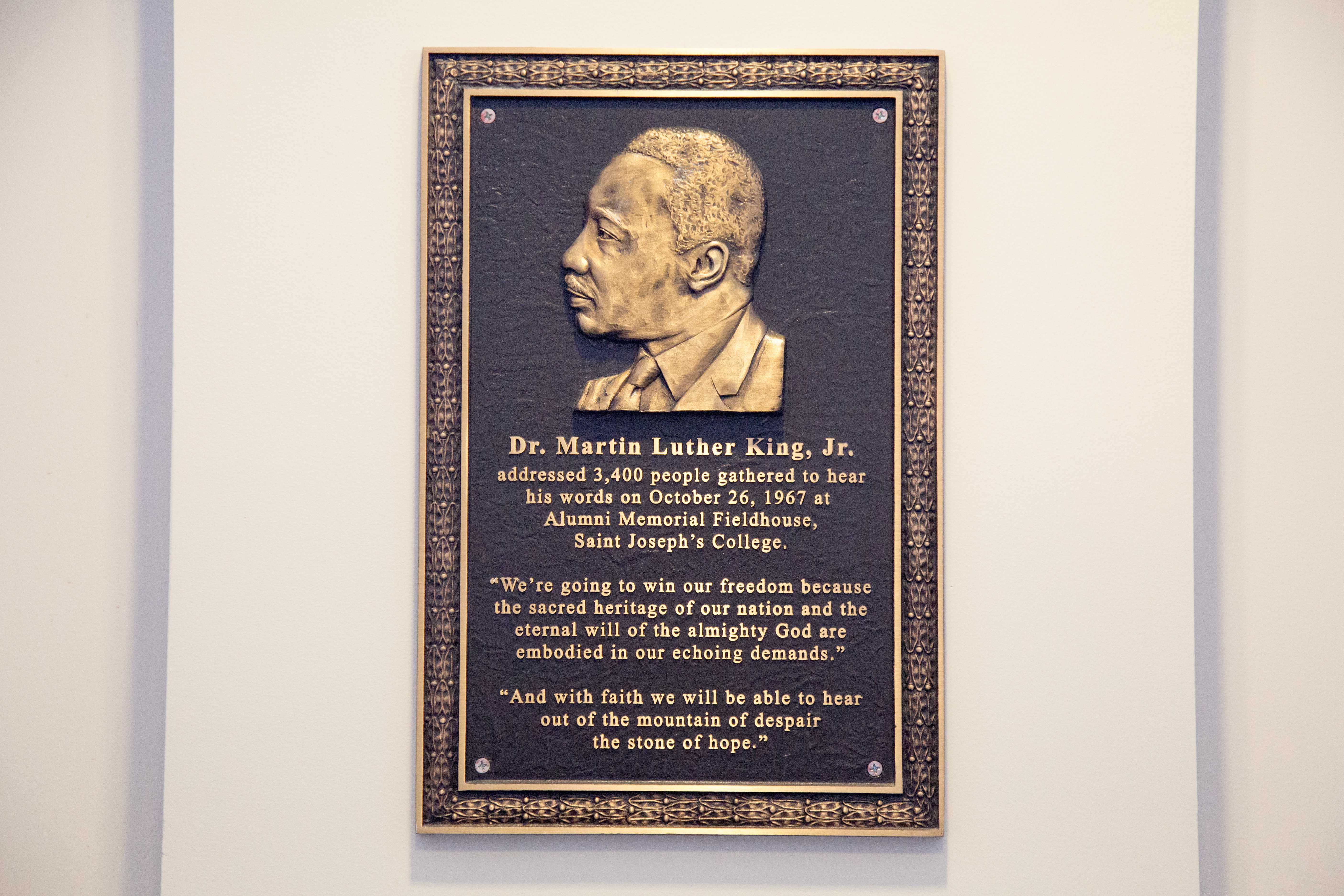Debunking the mystery behind the MLK transcript
The Martin Luther King Jr. commemorative plaque located in Saint Joseph’s University’s Michael J. Hagan Arena honors King’s visit to Saint Joseph’s College on Oct. 26, 1967.
The plaque, located by the ticket booth in Hagan Arena, has two quotes from the speech engraved in its bronze front, with one saying “We’re going to win our freedom because the sacred heritage of our nation and the eternal will of the almighty God are embodied in our echoing demands.” The second quote states : “And with faith we will be able to hear out of the mountain of despair the stone of hope.”
King never said either of these quotes.
Richard Haslam, Ph.D., associate professor of English wanted his students to read the speech King gave. He read the transcription from the event that was on the Office of Inclusion and Diversity’s (OID) website, while simultaneously listening to the audio excerpts. He realized the audio and the transcript did not match, which led him to believe that the incorrect quote came from the inaccurate transcription.
“As I read it [the transcript], I saw it was full of mistakes and errors,” Haslam said. “I went to the archives and listened, and had to listen a couple of times. I was looking at the Office of Inclusion and Diversity website, and I’d just been reading the transcript and I noticed some errors.”
Haslam also saw a photo of the plaque and realized that the quotes were wrong on there as well.
The corrected quote is: “We’re going to win our freedom because both the sacred heritage of our nation and the eternal will of the almighty God are embodied in our echoing demands.”
The second quote should say: “With this faith we will be able to hew out of the mountain of despair the stone of hope.”
King actually used both phrases in other speeches as well: the first one on March 31, 1968, and the other, containing the idea of a mountain of despair and a stone of hope, was actually from his “I Have a Dream” speech, delivered
in 1963.
Haslam believes the error in the second quote is more concerning, not only because it is incorrect, but because the metaphor was the inspiration for the Martin Luther King Jr. Memorial in Washington, D.C.
“The whole concept of the memorial is [that] the statue of Martin Luther King is hewed out of stone and behind him is the mountain of despair,” Haslam said. “The sculptor, [of] the memorial, was actually using this[incorrect] quotation for that.
Haslam notified university President Mark Reed, Ed.D, Monica Nixon, Ph.D., assistant provost of inclusion and diversity and Randall Miller, Ph.D., professor of history, when he discovered the mistake. He also sent Nixon a corrected transcript, which is the one now on the OID website.
Nixon said that the plaque is important because it honors King’s visit to campus and the university is currently working on having the plaque redone.
“I was very thankful to Professor Haslam that he was willing to do such a close listen and read of the transcription,” Nixon said. “It’s definitely still relevant to issues we’re discussing today, and I think about the rhetorical devices in the remarks and the historical elements and the policy elements. There’s so much to really dig into, in the text, and so the fact that we have a transcript that is more reliable is really a significant contribution.”
The speech was originally recorded on a reel-to-reel tape recorder, but was re-recorded onto a cassette tape. However, the reel-toreel recording went missing.
Christopher Dixon, Archival Research Librarian, said that even the cataloging of the speech was inaccurate.

Luke Malanga ’20).
“Within the note on the catalog that we had it did say reel-to-reel and I always
thought it was reel-to-reel,” Dixon said. “That was the information we had and that was what was in the record and I’ve since discovered that’s not the case. We have an audio cassette, we have a transcript and that’s basically what I’ve known.”
Another mysterious aspect of the transcription is neither Nixon, Haslam, nor Dixon know who wrote the first transcription of the speech or when it was transcribed. Dixon hypothesized that there were mistakes in the original speech, but was uncertain.
“I thought it was a possibility I’ve looked at the transcript in the past and noticed there were some gaps and little things missing,” Dixon said. “There are mistakes easily made when somebody’s transcribing
materials.”
The plaque in Hagan Arena is not the first time King has been misquoted. One of the quotes on the memorial in D.C., “I was a drum major for justice, peace and righteousness” was incorrect, and was removed from the statue in 2013. Famed American poet, Maya Angelou noticed the mistake and felt it made King seem conceited.
The correct quote is “Yes, if you want to say that I was a drum major, say that I was a drum major for justice, say that I was a
drum major for peace, I was a drum major for righteousness, and all the other shallow things will not matter.”
“I think it’ll be a good thing to have it corrected,” Dixon said. “We always want to be as accurate as possible when you’re dealing with historical figures and when you realize there’s been an unintentional mistake made, possibly because of the way the transcript was interpreted, then I think you would go about and correct that.”
Currently, it is unknown when the plaque will be corrected and how much it will cost the university.













































